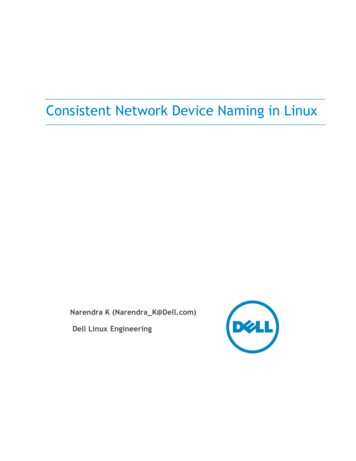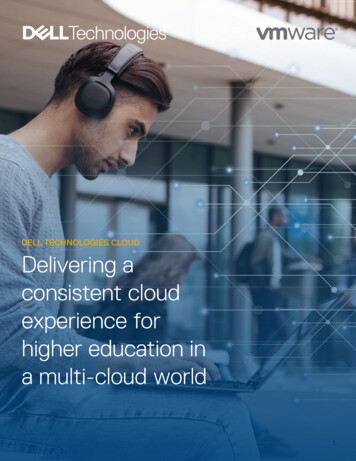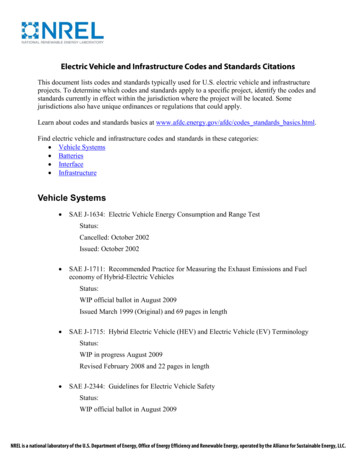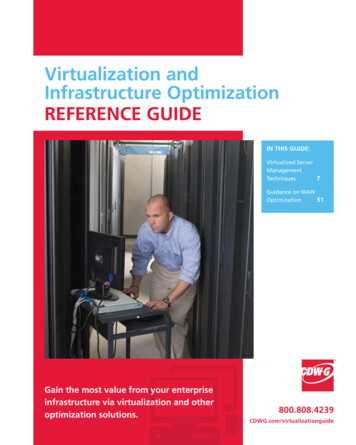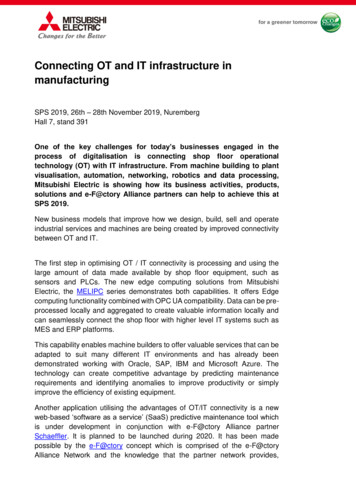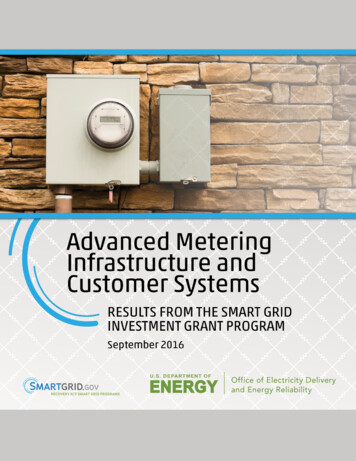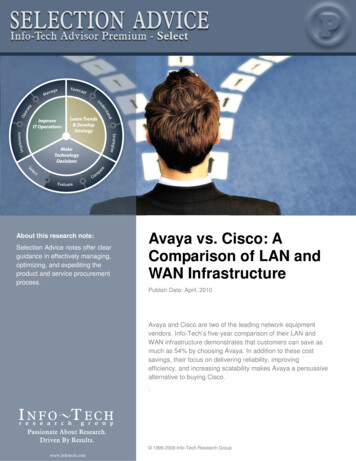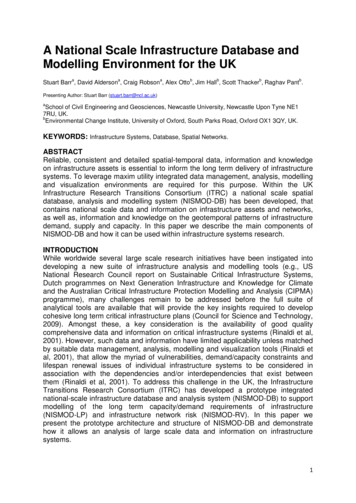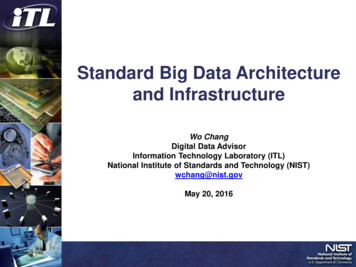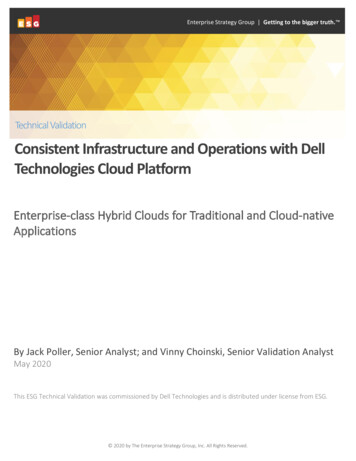
Transcription
Enterprise Strategy Group Getting to the bigger truth. Technical ValidationConsistent Infrastructure and Operations with DellTechnologies Cloud PlatformEnterprise-class Hybrid Clouds for Traditional and Cloud-nativeApplicationsBy Jack Poller, Senior Analyst; and Vinny Choinski, Senior Validation AnalystMay 2020This ESG Technical Validation was commissioned by Dell Technologies and is distributed under license from ESG. 2020 by The Enterprise Strategy Group, Inc. All Rights Reserved.
Technical Validation: Consistent Infrastructure and Operations with Dell Technologies Cloud Platform2ContentsIntroduction . 3Background . 3Dell Technologies Cloud Platform . 4ESG Technical Validation . 6VMware Cloud Builder and VMware Cloud Foundation . 6ESG Testing . 6SDDC Lifecycle Management . 9ESG Testing . 9VMware Tanzu Kubernetes Grid-Integrated . 14ESG Testing . 14The Bigger Truth . 19ESG Technical ValidationsThe goal of ESG Technical Validations is to educate IT professionals about informationtechnology solutions for companies of all types and sizes. ESG Technical Validations are not meant to replacethe evaluation process that should be conducted before making purchasing decisions, but rather to provideinsight into these emerging technologies. Our objectives are to explore some of the more valuablefeatures and functions of IT solutions, show how they can be used to solve real customer problems, andidentify any areas needing improvement. The ESG Validation Team’s expert third-party perspective is basedon our own hands-on testing as well as on interviews with customers who use these products in productionenvironments. 2020 by The Enterprise Strategy Group, Inc. All Rights Reserved.
Technical Validation: Consistent Infrastructure and Operations with Dell Technologies Cloud Platform3IntroductionThis ESG Technical Validation documents evaluation of Dell Technologies Cloud Platform. We evaluated how the platformenables organizations to extend their existing investments in infrastructure, people, and skills with a solution that providesday 0, day 1, and day 2 lifecycle management spanning public cloud, on-premises private cloud, and edge infrastructures.We also focused on how the solution integrates VxRail hyperconverged infrastructure, VMware Cloud Foundation, andVMware Tanzu Kubernetes Grid-Integrated (TKGI), unifying management, eliminating silos, and providing consistencyacross infrastructure, operations, and services.BackgroundAs organizations embrace digital transformation and the shift to modern cloud architectures, the infrastructure is bothgrowing and becoming more complex. According to recent ESG research, nearly two-thirds (64%) of respondents said thattheir IT environment had become more complex in the last two years. However, IT budgets aren’t keeping pace with thisgrowth and complexity, and organizations continue to give their IT leadership the mandate to “do more with less.” Thus,organizations seek increased employee productivity, improved business process, and reduced operating expenses fromtheir IT investments (see Figure 1).1Figure 1. Top Ten IT Investment JustificationsWhich of the following considerations do you believe will be most important in justifying ITinvestments to your organization’s business management team over the next 12 months?(Percent of respondents, top-10 responses, N 658, five responses accepted)Improves security/risk management36%Increases employee productivity34%Improves business process32%Enables digital transformation30%Improves customer experience29%Reduces operational expenditures27%Return on investment25%Improves regulatory compliance24%Improves employee experienceReduces capital expenditures23%22%Source: Enterprise Strategy GroupComplexity is never a good thing when it comes to IT infrastructures—complexity means using a multitude of disparatemanagement systems and APIs to deploy and maintain compute, storage, networking, virtualization, containerization, andthe cloud. Much of today’s modern environments are maintained by highly skilled IT staff using manual, repetitiveprocesses. While IT teams have begun the shift toward automation, these steps are haphazard, uncoordinated, and limitedto addressing immediate needs. Exacerbating the challenge, 34% of organizations report a problematic shortage oforchestration and automation skills.212Source: ESG Master Survey Results, 2020 Technology Spending Intentions Survey, January 2020.ibid. 2020 by The Enterprise Strategy Group, Inc. All Rights Reserved.
Technical Validation: Consistent Infrastructure and Operations with Dell Technologies Cloud Platform4Dell Technologies Cloud PlatformDell Technologies integrated a suite of infrastructure solutionsfrom Dell Technologies and VMware with the goal of providinga single, unified, consistent model and operating structure forhybrid cloud infrastructures. Dell Technologies designed thesolution based on three foundational architectural concepts:delivery of a turnkey solution, leveraging VxRail hyperconvergedinfrastructure (HCI); flexibility, with standardized designsincorporating VMware vSphere, vSAN, NSX, and CloudFoundation; and full management, incorporating automationand orchestration for simplification and consistency across day0 deployment, day 1 day-to-day operations, and day 2maintenance, updates, and expansions.Dell Technologies Cloud Platform provides a software-defineddata center (SDDC) abstraction with a hybrid cloud environmentand standardized infrastructure experience; a common set ofdata services for workloads; a common management model;and workloads abstracted and decoupled from the underlyinghardware to enable workload mobility.The Dell Technologies Cloud Platform SDDC abstraction is basedon VMware Cloud Foundation (VCF). The VCF Standardarchitecture separates workloads into workload domains such as a management domain, used to host the CloudFoundation management systems; a virtual infrastructure domain for typical and custom organization workloads; Horizondomains for Horizon virtual desktop workloads and management; and Tanzu Kubernetes Grid-Integrated (TKGI) domainsfor container workloads and management. As the solution uses VMware technologies including Cloud Foundation,organizations can move workload domains and workloads between their own private cloud and public clouds supportingCloud Foundation, such as VMware Cloud on AWS or Azure VMware Solutions.Dell Technologies and VMware co-engineered the solution, ensuring tight integration, orchestration, and automation of allcomponents. Organizations deploying Dell Technologies Cloud Platform benefit from: Consistency—Utilizing VMware Cloud Foundation on VxRail ensures consistent deployment, management,operations, and scaling across infrastructure, compute, storage, networking, and workloads, and ensures workloadmobility between public and private clouds. Simplicity—Co-engineering, tight integration, consistency, and the consolidation of compute, storage, andvirtualization into a single solution help to eliminate silos and redundant tools, simplifying deployment, operations,and scaling. Flexibility—A wide range of node hardware configuration options, consumption models, service models, anddeployment models provides flexibility, enabling organizations to right-size solutions to meet their performance,capacity, and budgetary requirements. Scalability—VxRail HCI is a clustered solution and can both scale up and scale out, enabling organizations to increasecompute and storage capacity and performance by adding nodes. Tight integration in the infrastructure managementstack automates and orchestrates expansions, simplifying infrastructure management. Nodes can be added to a 2020 by The Enterprise Strategy Group, Inc. All Rights Reserved.
Technical Validation: Consistent Infrastructure and Operations with Dell Technologies Cloud Platform5cluster in an automated, non-disruptive process. New nodes can be of different hardware configurations so newgenerations of hardware can be incorporated into existing clusters. Cloud mobility—VMware Cloud Foundation ensures organizations can migrate workloads between Dell TechnologiesCloud Platform and public clouds including Amazon Web Services (AWS), Microsoft Azure, Google Cloud Platform, andmore than 4,200 cloud partners. Agility—Using familiar VMware tools for provisioning, automation, orchestration, and governance acceleratesdeployment with a single operational hub for public, private, and edge clouds, and provides flexibility for workloadplacement. Modern architecture—Tanzu Kubernetes Grid-Integrated ensures highly available Kubernetes containerizedinfrastructure for running modern containerized applications in a flexible, multi-tenant environment. BOSH automatesand orchestrates lifecycle management of the Kubernetes infrastructure, and tight integration with the VMwareecosystem simplifies and accelerates the administrative workload. Unified architecture—The SDDC separates workloads into workload domains and supports existing applications,modern container-based applications, and virtual desktop environments, eliminating the need for separate siloedenvironments for different workloads. Single vendor experience—Dell Technologies Cloud Platform architecture is based on standardized VMware ValidatedDesigns, and Dell Technologies’ support organization tests all configurations, updates, and patches to ensureeffectiveness and compatibility. Customers can work directly with Dell Technologies for purchasing, deployment,services, financing, and full-stack solution support. 2020 by The Enterprise Strategy Group, Inc. All Rights Reserved.
Technical Validation: Consistent Infrastructure and Operations with Dell Technologies Cloud Platform6ESG Technical ValidationESG’s evaluation and testing of Dell Technologies Cloud Platform involved using an evaluation environment to simulate day0 deployment, day 1 operations and management, and day 2 updates and expansion of the unified and integrated privatecloud infrastructure. Our evaluation focused on the simplicity and consistency of management and operations of theinfrastructure, and how Dell Technologies and VMware co-engineering the platform resulted in an integrated solution thatprovides users with a consistent HCI infrastructure operations experience for both vSphere clusters on VxRail and hybridclouds using VCF on VxRail.VMware Cloud Builder and VMware Cloud FoundationESG’s evaluation of Dell Technologies Cloud Platform includeddeploying VCF on VxRail, SDDC lifecycle management, and TKGIlifecycle management.The evaluation environment consisted of a fresh deployment ofthree VxRail clusters. The first cluster was used as the CloudFoundation Management domain that must be fully deployedbefore installing Cloud Foundation management components.Using the native VxRail HCI System Software automationsimplified and accelerated our buildout of a vSphere clusterand helped accelerate installing the Cloud Foundationmanagement components. The second cluster was used forSDDC workloads and lifecycle management evaluation, and thethird cluster was used for TKGI workloads and lifecyclemanagement evaluation.ESG TestingESG started the evaluation by deploying VCF on VxRail. In this two-step process, we first deployed VMware Cloud Builderon top of a prebuilt VxRail four node cluster that was configured using the native automated VxRail Manager first runcluster build process, and then used Cloud Builder to deploy VCF on VxRail.Dell Technologies and VMware jointly engineered VMware Cloud Builder with VxRail integration. Thus, during the vSphereOVF deployment process, when we specified vcf-vxrail for the deployment type SKU, the deployment wizard used built-inknowledge of VxRail Manager APIs and services running on the VxRail cluster to automate and orchestrate deployment ofVCF onto the VxRail cluster, simplifying the installation and configuration process.Figure 2. Using VMware Cloud Builder to Install VMware Cloud Foundation on VxRailSource: Enterprise Strategy Group 2020 by The Enterprise Strategy Group, Inc. All Rights Reserved.
Technical Validation: Consistent Infrastructure and Operations with Dell Technologies Cloud Platform7At the end of the deployment process, we started the VMware Cloud Builder VM, and logged in to the Cloud Builder webportal to deploy VMware Cloud Foundation and build the base SDDC infrastructure, including the SDDC managementdomain.Dell Technologies and VMware provided a configuration worksheet that enabled us to pre-specify the configurationparameters. We filled out the worksheet and then uploaded it to the Cloud Builder. We clicked VALIDATE to verify ourconfiguration, and then clicked BEGIN BRING-UP to start the process.The unattended bring-up process completed after a few hours and automated numerous steps, including configuring ESXi,creating and configuring redundant platform services controllers (PSCs), and installing and configuring NSX and SDDCManager, eliminating the time and effort of manually installing, configuring, and verifying each component.As shown in Figure 3, Cloud Builder deployed three NSX-V Controller instances, one NSX-V Manager, two PSCs, one SDDCManager, and three vRealize Log Insight instances. Using vCenter, we observed that vSphere distributed resourcescheduler services (DRS) were enabled and configured for full automation. We also observed that the Cloud Builderinstalled and configured NSX-V, VXLANs, and default NSX-V firewall services, and that all services were operating normally,with no errors or alerts.Figure 3. The vSphere View of the SDDCSource: Enterprise Strategy GroupCloud Builder created a VCF management domain that can be used by administrators to manage the entire cloudinfrastructure. We logged in to VCF and reviewed the management domain. As shown in Figure 4, VCF displays the overallstatus and configuration of the domain, and provides tabs that enable administrators to review and modify domainconfiguration. We observed that VCF domains simplify the complex environment, and enable administrators to manage theinfrastructure using a higher level of abstraction, simplifying administrator workloads. 2020 by The Enterprise Strategy Group, Inc. All Rights Reserved.
Technical Validation: Consistent Infrastructure and Operations with Dell Technologies Cloud Platform8Figure 4. The Preconfigured Virtual Infrastructure Management DomainSource: Enterprise Strategy GroupWhy This MattersIT organizations quickly discover that delivering the simplicity, speed, accessibility, scalability, flexibility, self-service, andother benefits of private clouds can be a complex and painful exercise, requiring the coordination and integration ofmany components.ESG validated that Dell Technologies Cloud Platform automated and orchestrated the buildout of a private cloudinfrastructure. We pre-specified the desired configuration, and, leveraging built-in integration with VxRail, the vCenterOVF deployment wizard installed and configured the Cloud Builder virtual appliance. Then, using Cloud Builder, weautomatically built our private cloud infrastructure, installing and configuring Cloud Foundation, NSX-V, PSCs, andvRealize Log Insight in a high-availability cluster configuration.Cloud Builder reduces the burden on system architects by deploying a standardized, pretested cloud environmentarchitected using Dell Technologies and VMware best practices that are designed to obtain the best performance andsecurity. The deployment process leverages Dell Technologies and VMware co-engineering that incorporates knowledgeof VxRail into vSphere and Cloud Builder. This tight integration used VxRail APIs, automation, and orchestration tools toenable an unattended buildout of a hybrid cloud infrastructure running on VxRail HCI, reducing cloud architect andsystem administrator workloads by automating the complex and time-consuming effort of manually designing,installing, and configuring a complex cloud infrastructure with multiple disparate components. 2020 by The Enterprise Strategy Group, Inc. All Rights Reserved.
Technical Validation: Consistent Infrastructure and Operations with Dell Technologies Cloud Platform9SDDC Lifecycle ManagementThe full-stack integration of VMware Cloud Foundation (VCF) and VxRail Manager simplifies and automates lifecyclemanagement for day 0 deployment, day 1 operations, and day 2 maintenance, updates, and expansions.VCF helps administrators manage the software-defined data center, pooling and organizing resources into workloaddomains (policy-based resource containers with specific availability and performance attributes that combine vSphere,vSAN storage, and NSX networking into unified consumable entities). During the day 0 installation process, Cloud Buildercreates a management domain for managing the SDDC running on the VxRail cluster. Administrators can use VCF toautomate creation and deployment of domains for Horizon virtual desktop infrastructure (VDI), TKGI container workloads,and other virtual infrastructure workloads. These workload domains aggregate resources from one or more VxRail clustersthat have been added to those domains.Dell Technologies and VMware co-engineering results in full-stack integration, automation, and orchestration of theadministrative workload. Administrators can use VCF to manage VxRail-based hybrid cloud infrastructures including day 2VxRail hardware and the VMware software patch and update operations.ESG TestingESG’s evaluation of Dell Technologies Cloud Platform SDDClifecycle management included four steps. We created a newvirtual infrastructure (VI) workload domain to host enterpriseworkloads. To provide compute and storage resources forthe workload domain, we created a new VxRail cluster andadded the cluster to the VI workload domain. As the laststep, we evaluated day 2 lifecycle management by updatingthe VI workload domain.First, ESG created a virtual infrastructure workload domain to run application workloads. The steps involved in this processhave been designed to seamlessly integrate with the same native VxRail cluster management operational experience thathas been jointly engineered by Dell Technologies and VMware for all VxRail cluster management. This delivers a consistentHCI operations experience for administrators using VxRail for standard vSphere cluster deployments
Dell Technologies Cloud Platform Dell Technologies integrated a suite of infrastructure solutions from Dell Technologies and VMware with the goal of providing a single, unified, consistent model and operating structure for hybrid cloud infrastructures. Dell Technologies designed the sol
